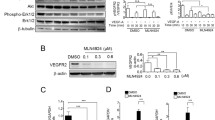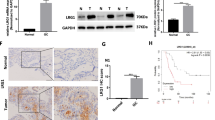Abstract
Aim
Delta-like 1 homolog (DLK1) is a non-canonical ligand of Notch signaling, which plays a pivotal role in vascular development and tumor angiogenesis. This study aimed to elucidate the function and mechanism of DLK1 in angiogenesis.
Methods and results
By using in situ hybridization and immunohistochemical studies, expression analysis revealed a unique vascular tropism of DLK1 in vasculature of neuroblastoma and vascular tumors. Thus, it was hypothesized that DLK1 may be cleaved and then bound to endothelial cells, thereby regulating the endothelial function. To test such hypothesis, soluble DLK1 encompassing DLK1 extracellular domain (DLK1-EC) was generated and validated by its inhibitory function in adipogenesis assay. Recombinant DLK1-EC exhibited the preferential binding capability toward endothelial cells and stimulated the microvessels sprouting in aorta rings. Above all, implantation of DLK1-EC dose-dependently elicited the cornea neovascularization in rats. By using various angiogenesis assays, it was delineated that DLK1-EC stimulated the angiogenesis by promoting the proliferation, motility and tube formation of endothelial cells. By immunoblot and luciferase analysis, it was elucidated that DLK1-EC enhanced the expression and activities of Notch1/Akt/eNOS/Hes-1 signaling in dose- and time-dependent manners. Pharmaceutical blockage of Notch signaling using γ-secretase inhibitor DAPT abrogated the DLK1-EC-induced endothelial migration and Hes-1-driven luciferase activities. Furthermore, Notch1 inactivation by neutralizing antibodies or RNA interference reversed the DLK1-EC-induced angiogenesis.
Conclusions
The present study unveils the pro-angiogenic function and mechanism of soluble DLK1 through activation of Notch1 signaling in endothelial cells.








Similar content being viewed by others
Change history
10 May 2018
In the original publication of the article, there is an error in one of the citations in the Discussion section.
References
Ranganathan P, Weaver KL, Capobianco AJ (2011) Notch signalling in solid tumours: a little bit of everything but not all the time. Nat Rev Cancer 11(5):338–351. https://doi.org/10.1038/nrc3035
Leong KG, Karsan A (2006) Recent insights into the role of Notch signaling in tumorigenesis. Blood 107(6):2223–2233. https://doi.org/10.1182/blood-2005-08-3329
Li JL, Harris AL (2005) Notch signaling from tumor cells: a new mechanism of angiogenesis. Cancer Cell 8(1):1–3
Rehman AO, Wang CY (2006) Notch signaling in the regulation of tumor angiogenesis. Trends Cell Biol 16(6):293–300
Takeshita K, Satoh M, Ii M, Silver M, Limbourg FP, Mukai Y, Rikitake Y, Radtke F, Gridley T, Losordo DW, Liao JK (2007) Critical role of endothelial Notch1 signaling in postnatal angiogenesis. Circ Res 100(1):70–78. https://doi.org/10.1161/01.RES.0000254788.47304.6e
del Monte G, Casanova JC, Guadix JA, MacGrogan D, Burch JB, Perez-Pomares JM, de la Pompa JL (2011) Differential Notch signaling in the epicardium is required for cardiac inflow development and coronary vessel morphogenesis. Circ Res 108(7):824–836. https://doi.org/10.1161/circresaha.110.229062
Laborda J, Sausville EA, Hoffman T, Notario V (1993) Dlk, a putative mammalian homeotic gene differentially expressed in small cell lung carcinoma and neuroendocrine tumor cell line. J Biol Chem 268(6):3817–3820
Smas CM, Sul HS (1993) Pref-1, a protein containing EGF-like repeats, inhibits adipocyte differentiation. Cell 73(4):725–734. https://doi.org/10.1016/0092-8674(93)90252-L
Jensen CH, Krogh TN, Hojrup P, Clausen PP, Skjodt K, Larsson LI, Enghild JJ, Teisner B (1994) Protein structure of fetal antigen 1 (FA1). A novel circulating human epidermal-growth-factor-like protein expressed in neuroendocrine tumors and its relation to the gene products of dlk and pG2. Eur J Biochem 225(1):83–92
Lee YL, Helman L, Hoffman T, Laborda J (1995) dlk, pG2 and Pref-1 mRNAs encode similar proteins belonging to the EGF-like superfamily. Identification of polymorphic variants of this RNA. Biochim Biophys Acta 1261(2):223–232
Wang Y, Sul HS (2006) Ectodomain shedding of preadipocyte factor 1 (Pref-1) by tumor necrosis factor alpha converting enzyme (TACE) and inhibition of adipocyte differentiation. Mol Cell Biol 26(14):5421–5435
Hsiao CC, Huang CC, Sheen JM, Tai MH, Chen CM, Huang LL, Chuang JH (2005) Differential expression of delta-like gene and protein in neuroblastoma, ganglioneuroblastoma and ganglioneuroma. Mod Pathol 18(5):656–662
Lim JY, Kim YS, Kim Y (2013) β-carotene regulates the murine liver microenvironment of a metastatic neuroblastoma. J Cancer Prev 18(4):337–345
Charalambous M, Da Rocha ST, Radford EJ, Medina-Gomez G, Curran S, Pinnock SB, Ferron SR, Vidal-Puig A, Ferguson-Smith AC (2014) DLK1/PREF1 regulates nutrient metabolism and protects from steatosis. Proc Natl Acad Sci USA 111(45):16088–16093. https://doi.org/10.1073/pnas.1406119111
Li H, Cui ML, Chen TY, Xie HY, Cui Y, Tu H, Chen FH, Ge C, Li JJ (2015) Serum DLK1 is a potential prognostic biomarker in patients with hepatocellular carcinoma. Tumour Biol 36(11):8399–8404. https://doi.org/10.1007/s13277-015-3607-8
Baladron V, Ruiz-Hidalgo MJ, Gubina E, Bonvini E, Laborda J (2001) Specific regions of the extracellular domain of dlk, an EGF-like homeotic protein involved in differentiation, participate in intramolecular interactions. Front Biosci 6:A25–A32
Laborda J (2000) The role of the epidermal growth factor-like protein dlk in cell differentiation. Histol Histopathol 15(1):119–129
Smas CM, Sul HS (1997) Molecular mechanisms of adipocyte differentiation and inhibitory action of pref-1. Crit Rev Eukaryot Gene Expr 7(4):281–298
Smas CM, Chen L, Sul HS (1997) Cleavage of membrane-associated pref-1 generates a soluble inhibitor of adipocyte differentiation. Mol Cell Biol 17(2):977–988
Li L, Forman SJ, Bhatia R (2005) Expression of DLK1 in hematopoietic cells results in inhibition of differentiation and proliferation. Oncogene 24(27):4472–4476
Persson-Augner D, Lee YW, Tovar S, Dieguez C, Meister B (2014) Delta-like 1 homologue (DLK1) protein in neurons of the arcuate nucleus that control weight homeostasis and effect of fasting on hypothalamic DLK1 mRNA. Neuroendocrinology 100(2–3):209–220. https://doi.org/10.1159/000369069
Tornehave D, Jensen CH, Teisner B, Larsson LI (1996) FA1 immunoreactivity in endocrine tumours and during development of the human fetal pancreas; negative correlation with glucagon expression. Histochem Cell Biol 106(6):535–542
Tanimizu N, Tsujimura T, Takahide K, Kodama T, Nakamura K, Miyajima A (2004) Expression of Dlk/Pref-1 defines a subpopulation in the oval cell compartment of rat liver. Gene Expr Patterns 5(2):209–218
Cooper MJ, Hutchins GM, Cohen PS, Helman LJ, Mennie RJ, Israel MA (1990) Human neuroblastoma tumor cell lines correspond to the arrested differentiation of chromaffin adrenal medullary neuroblasts. Cell Growth Differ 1(4):149–159
Costaglioli P, Come C, Knoll-Gellida A, Salles J, Cassagne C, Garbay B (2001) The homeotic protein dlk is expressed during peripheral nerve development. FEBS Lett 509(3):413–416
Falix FA, Aronson DC, Lamers WH, Gaemers IC (2012) Possible roles of DLK1 in the Notch pathway during development and disease. Biochem Biophys Acta 1822(6):988–995. https://doi.org/10.1016/j.bbadis.2012.02.003
Abdallah BM, Boissy P, Tan Q, Dahlgaard J, Traustadottir GA, Kupisiewicz K, Laborda J, Delaisse JM, Kassem M (2007) dlk1/FA1 regulates the function of human bone marrow mesenchymal stem cells by modulating gene expression of pro-inflammatory cytokines and immune response-related factors. J Biol Chem 282(10):7339–7351
Huang CC, Chuang JH, Huang LL, Chou MH, Wu CL, Chen CM, Hsieh CS, Lee SY, Chen CL (2004) The human Delta-like 1 homologue is implicated in the progression of liver fibrosis in biliary atresia. J Pathol 202(2):172–179. https://doi.org/10.1002/path.1505
Lin TM, Tsai JL, Lin SD, Lai CS, Chang CC (2005) Accelerated growth and prolonged lifespan of adipose tissue-derived human mesenchymal stem cells in a medium using reduced calcium and antioxidants. Stem Cells Dev 14(1):92–102. https://doi.org/10.1089/scd.2005.14.92
Chen SC, Hu TH, Huang CC, Kung ML, Chu TH, Yi LN, Huang ST, Chan HH, Chuang JH, Liu LF, Wu HC, Wu DC, Chang MC, Tai MH (2015) Hepatoma-derived growth factor/nucleolin axis as a novel oncogenic pathway in liver carcinogenesis. Oncotarget 6(18):16253–16270
Lin SW, Huang SC, Kuo HM, Chen CH, Ma YL, Chu TH, Bee YS, Wang EM, Wu CY, Sung PJ, Wen ZH, Wu DC, Sheu JH, Tai MH (2015) Coral-derived compound WA-25 inhibits angiogenesis by attenuating the VEGF/VEGFR2 signaling pathway. Mar Drugs 13(2):861–878. https://doi.org/10.3390/md13020861
Wu PC, Yang LC, Kuo HK, Huang CC, Tsai CL, Lin PR, Shin SJ, Tai MH (2005) Inhibition of corneal angiogenesis by local application of vasostatin. Mol Vis 11:28–35
Lam HC, Kuo SM, Chuang MJ, Keng HM, Lin PR, Liu GS, Hsu CM, Howng SL, Tai MH (2006) Blockade of endothelin-1 release contributes to the anti-angiogenic effect by pro-opiomelanocortin overexpression in endothelial cells. Exp Biol Med (Maywood) 231(6):782–788
Tai MH, Kuo SM, Liang HT, Chiou KR, Lam HC, Hsu CM, Pownall HJ, Chen HH, Huang MT, Yang CY (2006) Modulation of angiogenic processes in cultured endothelial cells by low density lipoproteins subfractions from patients with familial hypercholesterolemia. Atherosclerosis 186(2):448–457. https://doi.org/10.1016/j.atherosclerosis.2005.08.022
Wang CR, Shiau AL, Chen SY, Lin LL, Tai MH, Shieh GS, Lin PR, Yo YT, Lee CH, Kuo SM, Liu MF, Jou IM, Yang CY, Shen PC, Lee HL, Wu CL (2008) Amelioration of collagen-induced arthritis in rats by adenovirus-mediated PTEN gene transfer. Arthritis Rheum 58(6):1650–1656. https://doi.org/10.1002/art.23517
Kao YH, Chen CL, Jawan B, Chung YH, Sun CK, Kuo SM, Hu TH, Lin YC, Chan HH, Cheng KH, Wu DC, Goto S, Cheng YF, Chao D, Tai MH (2010) Upregulation of hepatoma-derived growth factor is involved in murine hepatic fibrogenesis. J Hepatol 52(1):96–105. https://doi.org/10.1016/j.jhep.2009.10.002
Hudak CS, Sul HS (2013) Pref-1, a gatekeeper of adipogenesis. Front Endocrinol (Lausanne) 4:79. https://doi.org/10.3389/fendo.2013.00079
Yamada T, Higuchi M, Nakanishi N (2015) Effect of the anatomical site on telomere length and pref-1 gene expression in bovine adipose tissues. Biochem Biophys Res Commun 463(4):923–927. https://doi.org/10.1016/j.bbrc.2015.06.036
Baladron V, Ruiz-Hidalgo MJ, Nueda ML, Diaz-Guerra MJ, Garcia-Ramirez JJ, Bonvini E, Gubina E, Laborda J (2005) dlk acts as a negative regulator of Notch1 activation through interactions with specific EGF-like repeats. Exp Cell Res 303(2):343–359
Kawasaki K, Smith RS Jr, Hsieh CM, Sun J, Chao J, Liao JK (2003) Activation of the phosphatidylinositol 3-kinase/protein kinase Akt pathway mediates nitric oxide-induced endothelial cell migration and angiogenesis. Mol Cell Biol 23(16):5726–5737
Shiojima I, Walsh K (2002) Role of Akt signaling in vascular homeostasis and angiogenesis. Circ Res 90(12):1243–1250
Yin D, Xie D, Sakajiri S, Miller CW, Zhu H, Popoviciu ML, Said JW, Black KL, Koeffler HP (2006) DLK1: increased expression in gliomas and associated with oncogenic activities. Oncogene 25(13):1852–1861
Traustadottir GA, Jensen CH, Thomassen M, Beck HC, Mortensen SB, Laborda J, Baladron V, Sheikh SP, Andersen DC (2016) Evidence of non-canonical NOTCH signaling: delta-like 1 homolog (DLK1) directly interacts with the NOTCH1 receptor in mammals. Cell Signal 28(4):246–254. https://doi.org/10.1016/j.cellsig.2016.01.003
Klose R, Berger C, Moll I, Adam MG, Schwarz F, Mohr K, Augustin HG, Fischer A (2015) Soluble Notch ligand and receptor peptides act antagonistically during angiogenesis. Cardiovasc Res 107(1):153–163. https://doi.org/10.1093/cvr/cvv151
Shaulian E, Karin M (2002) AP-1 as a regulator of cell life and death. Nat Cell Biol 4(5):E131–E136. https://doi.org/10.1038/ncb0502-e131
Liu ZJ, Xiao M, Balint K, Smalley KS, Brafford P, Qiu R, Pinnix CC, Li X, Herlyn M (2006) Notch1 signaling promotes primary melanoma progression by activating mitogen-activated protein kinase/phosphatidylinositol 3-kinase-Akt pathways and up-regulating N-cadherin expression. Cancer Res 66(8):4182–4190
Murohara T, Asahara T, Silver M, Bauters C, Masuda H, Kalka C, Kearney M, Chen D, Symes JF, Fishman MC, Huang PL, Isner JM (1998) Nitric oxide synthase modulates angiogenesis in response to tissue ischemia. J Clin Invest 101(11):2567–2578. https://doi.org/10.1172/JCI1560
Acknowledgements
We thank Chang Gung Medical Foundation and Tissue Bank of Kaohsiung Chang Gung Memorial Hospital (CLRPG8B0031 and CLRPG8B0033) for technical support.
Funding
This work was supported by Grants from the Ministry of Science and Technology, Taiwan (MOST 102-2325-B-110-001 to MHT, MOST 98-2320-B-182-023-MY3 and MOST 101-2320-B-182-009 to CCH), Chang Gung Memorial Hospital (CMRPG890303 and CMRPG891091), NSYSU-KMU Joint Research Project (NSYSUKMU104-P039) and the Center for Stem Cell Research, Kaohsiung Medical University, Taiwan (KMU-TP105G01).
Author information
Authors and Affiliations
Corresponding authors
Ethics declarations
Conflict of interest
The authors declare that they have no conflict of interest.
Electronic supplementary material
Below is the link to the electronic supplementary material.
Rights and permissions
About this article
Cite this article
Huang, CC., Kuo, HM., Wu, PC. et al. Soluble delta-like 1 homolog (DLK1) stimulates angiogenesis through Notch1/Akt/eNOS signaling in endothelial cells. Angiogenesis 21, 299–312 (2018). https://doi.org/10.1007/s10456-018-9596-7
Received:
Accepted:
Published:
Issue Date:
DOI: https://doi.org/10.1007/s10456-018-9596-7




